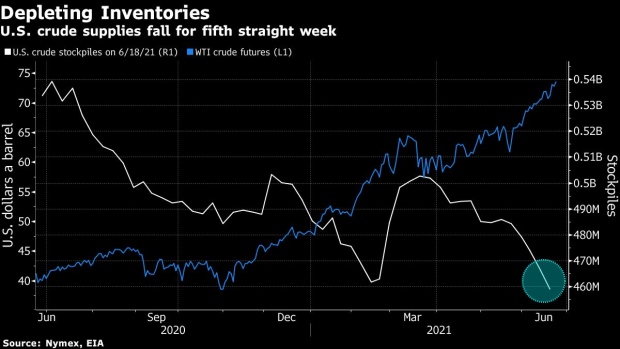Jun 23, 2021
Oil pares gains with crude overbought as U.S. supplies slide
, Bloomberg News

Oil pared gains with technical indicators showing the commodity is overbought, while traders assessed depleting U.S. stockpiles.
Futures in New York closed 0.3 per cent higher on Wednesday with West Texas Intermediate’s 14-day Relative Strength Index clinging near 70, a level that signals oil is due for a pullback. Meanwhile, a U.S. government report earlier showed crude supplies, gasoline inventories and stockpiles at the nation’s largest storage hub at Cushing, Oklahoma, all tumbled last week, reinforcing the expectation of limited supply during the summer driving season.
Supply declines in the U.S. are the latest sign of a tightening global crude market as fuel demand bounces back from the pandemic. Stalled nuclear talks have also deferred the prospect of renewed Iranian supplies, keeping benchmark crude prices supported. However, OPEC+ is scheduled to meet next week to discuss its production policy for August and beyond, and some nations, most notably Russia, are considering backing an increase in output.

“We’re at lofty levels and priced for bullish perfection,” said John Kilduff, a partner at Again Capital LLC. “Chatter about increasing output are going to tear away some of the gains.”
Saudi Arabia’s Energy Minister said the OPEC+ alliance has a role in “taming and containing” inflationary pressures. Prince Abdulaziz said the group should remain cautious because the oil market wasn’t out of the “doldrums” created by the coronavirus pandemic.
Prices
- West Texas Intermediate crude futures for August delivery added 23 cents to settle at US$73.08 a barrel in New York.
- Brent for August settlement climbed 38 cents to end the session at US$75.19 a barrel on the London-based ICE Futures Europe exchange, the highest since 2018.
Investors are also watching the spread of the delta variant in the U.S. and Europe, which could hamper a further recovery. The growing threat of the variant prompted a fresh warning on Wednesday from Europe’s disease prevention agency to speed up vaccinations and not rush reopening.
“Those are the big concerns: the delta variant causing new lockdowns, progress on Iranian sanctions and Saudi Arabia or Russia increasing production levels,” said Phil Streible, chief market strategist at Blue Line Futures LLC in Chicago.
Meanwhile, in the U.S., the Energy Information Administration report also showed crude production ticked lower last week. The U.S. shale patch, which has held output steady in the face of rising crude prices, is gearing up for a global supply shortage in the next few years, according to a survey of executives and company owners by the Federal Reserve Bank of Dallas.
Other market news:
- The physical market for North Sea crude is showing signs of strength as traders step up bidding for barrels in the market’s main pricing window and an important spread reaches its highest since before the pandemic hit demand.
- Iran and the U.S. are haggling over problems with the nuclear deal that predated the Trump administration’s 2018 withdrawal from the accord, a top Iranian government official said, suggesting that negotiations to bring Washington back into the fold have become more complicated than previously known.
- Soaring oil prices may bring record cash to the industry this year as companies continue to limit investments, Rystad Energy AS said.


